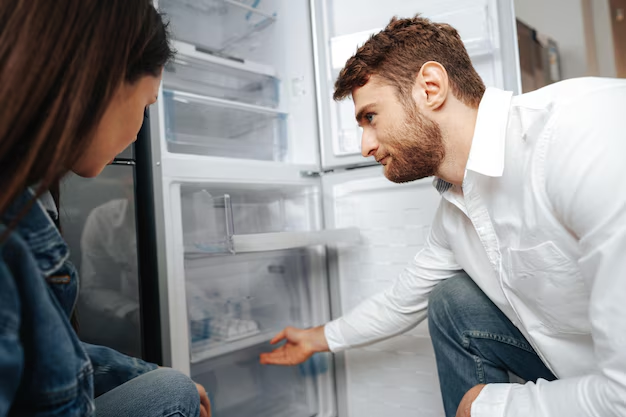Is Your Refrigerator Failing to Keep Things Cool? Here's What You Need to Know!
Refrigerators play a vital role in our daily lives, preserving food and keeping beverages refreshingly cool. But when the temperature inside the fridge starts to rise and your food is no longer kept cold, it becomes a source of stress and frustration. If you find yourself asking, "Why is my refrigerator not cooling?" don't despair. This guide will walk you through possible causes and solutions, empowering you to troubleshoot the problem effectively.
🧊 How Refrigerators Work: A Quick Overview
Before diving into troubleshooting, it's helpful to understand the basics of how a refrigerator operates. Refrigerators function by using a coolant system where a compressor, evaporator, and condenser work in harmony to keep the internal temperature at a constant cool level.
- Compressor: It compresses the refrigerant, raising its temperature and pressure.
- Condenser Coils: These dissipate heat as the refrigerant passes through them.
- Evaporator Coils: Located inside the fridge, these absorb heat from the interior, cooling it down.
When any part of this cycle malfunctions, it can lead to issues with cooling.
🤔 Common Reasons Why Refrigerators Stop Cooling
Below are some of the typical culprits behind a fridge not maintaining its cool:
1. Thermostat Settings
- Overview: If the temperature dial is set too high, your fridge might not be cooling effectively.
- Solution: Ensure the thermostat is set between 37°F to 40°F. Adjustments can be made based on your specific refrigerator model.
2. Blocked Vents
- Overview: Air circulation is essential for maintaining the temperature throughout the fridge.
- Solution: Check that vents aren’t blocked by food or containers.
3. Dirty Condenser Coils
- Overview: Dust and debris on the condenser coils can stifle the cooling process as they prevent efficient heat dissipation.
- Solution: Clean the condenser coils with a brush or vacuum every six months.
4. Faulty Compressor
- Overview: The heart of the refrigerator, the compressor, pumps refrigerant through the system. If it's not working, the fridge won’t cool.
- Solution: A failing compressor may need repair or replacement by a professional.
5. Evaporator Fan Malfunction
- Overview: This fan circulates cold air within the fridge. If it fails, parts of your fridge may stay warm.
- Solution: Inspect or replace the fan if it’s not running.
6. Door Seal Issues
- Overview: A weak or damaged door seal can let warm air inside.
- Solution: Check the seal for gaps or tears and replace if necessary.
🛠️ Troubleshooting Guide: Detailed Steps for Resolving Cooling Issues
When your fridge isn’t cooling as it should, try these step-by-step methods before calling a technician.
Step 1: Check the Power Supply
- Ensure the fridge is plugged in and the outlet is functioning. Test the outlet with another device.
Step 2: Adjust the Thermostat
- Locate the thermostat dial and make sure it’s set to the recommended temperature.
Step 3: Inspect for Blocked Air Vents
- Rearrange items in the fridge to ensure air can flow from the vents.
Step 4: Clean the Condenser Coils
- Turn off and unplug the fridge before cleaning coils with a coil brush.
Step 5: Test the Door Seal
- Close the door on a piece of paper. If it pulls out without resistance, the seal may need replacing.
Step 6: Listen for the Evaporator Fan
- Open the fridge door and listen for the fan turning off. If silent, the fan may need inspection.
🔧 When to Seek Professional Help
Even after performing basic troubleshooting, some refrigerator issues might require a professional touch. Here’s when to consider calling in an expert:
- If the compressor is making unusual noises or seems excessively hot.
- Circuit boards or complex electronic components appear to be malfunctioning.
- Persistent leaks inside or outside the fridge.
- Any refrigerant-related issues, as these require specialized handling.
🌿 Energy Efficiency Tips for Refrigerators
To prevent future cooling problems and save on energy costs, consider these eco-friendly tips:
- Regular Maintenance: Schedule routine cleanings of coils and checks on fans.
- Keep it Stocked: A well-stocked fridge maintains temperature better than an empty one.
- Position Wisely: Keep the fridge away from heat sources like ovens and direct sunlight.
📍 Summary: Key Takeaways for Optimal Refrigerator Performance
Here’s a quick recap to ensure your fridge stays in top condition:
- 🔌 Power & Thermostat: Confirm they're properly set to avoid operational hiccups.
- 🧼 Clean Coils: Every six months, clean the condenser coils.
- 🚪 Seal the Deal: Check door seals for any gaps to keep cold air in.
- 🔄 Ventilation: Leave space around vents and the appliance itself for good airflow.
Maintaining your refrigerator involves vigilance and routine check-ups, but it pays off with reliable performance and extended appliance life. If issues persist despite your best efforts, professional assistance ensures both a swift and safe solution.
With this guide, you now have the tools and insights needed to address and understand the most common refrigerator cooling issues. Remember, good maintenance habits not only help avoid cooling problems but also enhance energy efficiency, saving you money in the long run. Keep your cool and enjoy your perfectly chilled kitchen companion!
